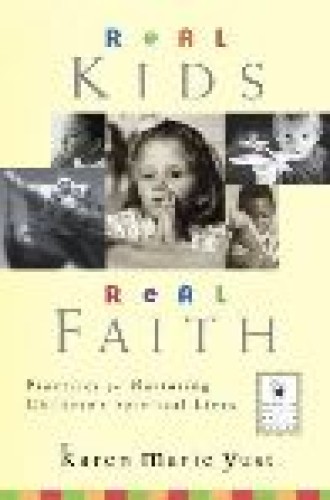Real Kids, Real Faith: Practices for Nurturing Children's Spiritual Lives
I wish this book had been around 20 years ago. If I had read it when my daughters were small, it would have reassured me about some of my decisions, challenged me to make some different choices, and clarified my thinking about the difficult business of raising children in the faith. As I read the chapter on praying with children, I wished I had, as Karen Marie Yust suggests, encouraged our children to share the pain and fear in their young lives in the classic form of the psalms of lament. If they had brought their sorrows and angers before God in this ancient way, what depths of honesty and trust might they have discovered in themselves? Yust’s guidelines for finding a genuinely child-friendly community of faith might have emboldened me to ask more of the adult-focused churches we were part of in those days.
Mostly, though, in reading Real Kids, Real Faith with a retrospective eye on my daughters’ childhoods, I felt encouraged and cheered by the memory of what we had (largely unconsciously) provided them at home. In the section on “creating an everyday spiritual world,” for instance, Yust leads readers on a tour of her own family’s home, pointing out the objects that act as “markers of the spiritual life.” With much the same sense of relief and gratitude I felt in reading Bruno Bettelheim’s A Good Enough Parent, I realized that we, too, had surrounded our children with “daily reminders of our connection to God and God’s desire to be known”—in the form of battered sets of C. S. Lewis’s Narnia Chronicles, reproductions of great Christian art from all over the world, and hand-crafted mementos from the Latin American and African villages where my husband’s nonprofit organization provides clean drinking water.
At Sunday school, however, our daughters were heirs to the theory of religious pedagogy which holds (as Yust summarizes it) that “the primary goal of children’s spiritual formation is keeping children entertained . . . until they are old enough to engage in real religious practices.” Yust believes that children are real people, capable of real faith, who deserve better than what they usually get in religious education, both at church and at home.
Combining the insights of developmental psychology with classic Christian spirituality, Yust makes frequent and cogent reference both to her own experience as a mother, teacher and pastor and to scholarship in her academic field, Christian education. The resulting wealth of theological reflection and practical suggestion is immensely valuable—and possibly revolutionary—for parents, clergy and directors of children and youth programming.
Yust does not recommend treating children as miniature adults, capable of adult responses to their experiences of God—though she does insist that children are born with a capacity for wonder, joy and love, and can, within the limits set by their psychological development, respond to the presence of God in their lives. Defining faith in relational rather than cognitive-dogmatic terms, she suggests that children are capable of far more (including guided meditation and contemplative silence) than teachers and parents may realize. She also reminds us that children are in dire need of adult guidance to help them negotiate the tensions between the dominant American culture and the countervailing values of the community of faith.
Here the book addresses the issues that concerned me most as a parent: how to engage even young children in religious practices that include the whole world in the frame and that address issues of social justice as an indispensable part of Christian faith and life. But this is where the book seems a bit thin. I was struck by the relative narrowness of its implicit worldview, even as I took note of the wealth of what it offers.
In a chapter dealing with acting for justice as a spiritual discipline, Yust encourages parents to include children in such activities as creating gift bags for children in local hospitals, cleaning up playgrounds and befriending the new kid at school. However, the only suggestion for action outside the local community is trick-or-treating for UNICEF, which even I did as a child and which did little to deepen my awareness of the plight of the world’s children (although it certainly educated me about the hostility toward the United Nations in my small Kansas town).
To foster a sense of responsibility and community beyond our own borders is more difficult than fostering it within our neighborhoods, but it is equally important. In the context of Bible lessons on texts like Matthew 25 (“as you did it to one of the least of these . . .”) or Matthew 10:42 (“whoever gives to one of these little ones even a cup of cold water . . .”), even very young children can begin to imagine the hunger and thirst of many of the world’s children, and be helped to respond in concrete and practical ways.
However, this is a small criticism of an excellent book. Many of Yust’s recommendations would foster spiritual growth in adults as well as children. Like most spiritual directors, I spend a lot of time listening to people whose images of God and assumptions about prayer have been warped by a weak, shallow or ill-conceived early religious education. A veteran Sunday school teacher once insisted that the whole point of religious education is to teach children the gospel in such a way that they will have to “unlearn” as little of it as possible in later life. If parents and churches put the wisdom of this book into practice, far less unlearning will be required.





